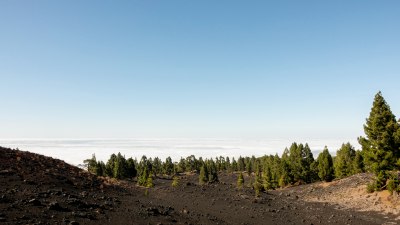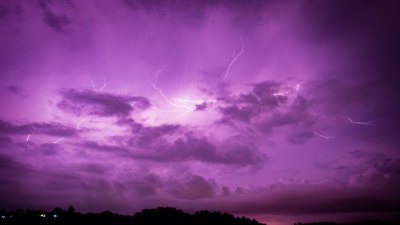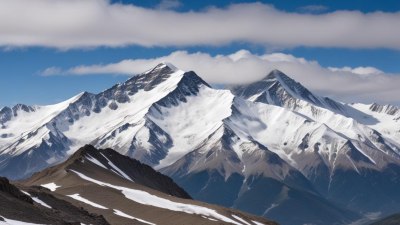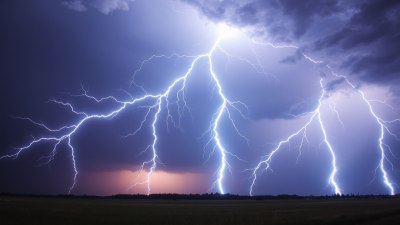How Ground Temperature Affects Precipitation Type
Explore how variations in ground temperature influence the type of precipitation that reaches the surface, from rain to snow to freezing rain.

Precipitation, in all its diverse forms, is a complex atmospheric phenomenon influenced by a myriad of factors. Among these, ground temperature plays a pivotal role in determining the type of precipitation that actually reaches the earth's surface. While meteorologists often focus on atmospheric conditions aloft, the temperature near the ground can dramatically affect whether precipitation falls as rain, snow, sleet, or freezing rain. Understanding these dynamics is critical for accurate weather forecasting and for anticipating the potential impacts on transportation, agriculture, and daily life.
In essence, precipitation type depends on the vertical temperature profile of the atmosphere, not just the temperature on the ground. However, once precipitation particles descend through various atmospheric layers, the ground temperature can dictate how precipitation interacts with the surface and whether it undergoes any transformations in its final state.
The Basics of Precipitation Formation
Precipitation begins as water vapor rising and cooling in the atmosphere. As the vapor condenses into cloud droplets and ice crystals, these particles grow heavier and eventually fall to the ground as precipitation. The initial form of precipitation is typically snow or ice crystals in colder upper layers of the atmosphere. However, as these particles fall, they pass through layers of air with varying temperatures, which can cause melting, refreezing, or retaining of the original frozen state.
Ground temperature, typically measured at a height of around 1.5 to 2 meters above the surface, provides an essential context because it influences the final transformation of precipitation just before it contacts the Earth. Different precipitation types can result from similar atmospheric conditions depending on surface temperature differences.
Types of Precipitation Influenced by Ground Temperature
There are several main types of precipitation, and understanding how ground temperature affects each provides clarity on their occurrence:
- Snow: For snow to reach the ground as snowflakes, both the air column and the ground layer must remain at or below freezing (0°C or 32°F). If ground temperatures are above freezing, snowflakes may melt partially or fully, resulting in rain or wet snow.
- Rain: When air temperatures and ground temperatures are above freezing, precipitation generally falls as rain. Melting of any initially frozen precipitation typically occurs before reaching the surface.
- Sleet: Also called ice pellets, sleet forms when snowflakes partially melt in a warm layer above freezing and then pass through a deeper subfreezing layer near the ground, refreezing into small ice pellets before impact.
- Freezing Rain: Freezing rain happens when precipitation falls as liquid rain in a warm layer aloft but encounters a near-surface subfreezing layer that is too shallow for sleet formation, causing the raindrops to freeze upon contact with cold surfaces.
The Vertical Temperature Profile and its Impact
The temperature profile of the atmosphere is key to precipitation type. This profile consists of layers that vary in temperature, which can be warmer or colder than freezing. A classic method for visualizing this is the sounding, used by meteorologists to measure the temperature at various altitudes.
When snow forms in cold upper layers, its journey to the ground depends on the temperatures it encounters. For example, if there is a deep above-freezing layer, the snow will melt completely and fall as rain. If the melting layer is shallow but followed by a deeper subfreezing layer near the surface, sleet is likely. If the subfreezing layer near the surface is shallow and not cold enough to refreeze the drops before hitting the ground, then freezing rain can occur.
Ground Temperature as a Key Distribution Factor
While the main transformation of precipitation typically happens mid-air, ground temperature can influence the distribution and accumulation of these precipitation types. Consider the case of freezing rain: if the ground temperature is slightly above freezing, the rain will not immediately freeze upon impact but may cool surfaces enough over time to form ice layers. Conversely, if the ground is cold, surfaces may already be below freezing, causing instant ice formation leading to hazardous conditions.
In addition, urban heat islands — areas where concrete and buildings raise local temperatures — can create localized zones where precipitation type differs from nearby rural areas. For instance, a city might experience rain while surrounding suburbs get freezing rain or sleet. This phenomenon underscores how subtle variations in ground temperature profiles can manifest in different precipitation experiences over short distances.
Seasonal Variations in Ground Temperature Effects
During autumn and late spring, ground temperatures often hover near the freezing mark, resulting in frequent shifts in precipitation type. In winter, the ground tends to be colder, supporting snow accumulation. Yet, during warming periods or rain-on-snow events, the interplay of atmospheric and ground temperatures complicates the precipitation outcome.
Moreover, early or late season snowfalls often struggle to accumulate if ground temperatures remain above freezing, causing rapid melting. Conversely, a cold ground can preserve snowpack and affect local climate by reflecting solar radiation, which further impacts temperature and precipitation patterns.
Impacts on Infrastructure and Safety
The interaction between precipitation type and ground temperature has significant implications for infrastructure and public safety. Freezing rain, which requires a cold ground surface, is notorious for creating icy roads and power outages due to ice accumulation. Accurate knowledge of surface temperatures helps in predicting and mitigating these hazards.
Similarly, communities dependent on snow accumulation for winter sports or water resources pay close attention to ground conditions to understand how snowpack will develop and sustain. When rain falls on cold ground, it may reduce snowpack or cause ice crusts that affect wildlife, soil moisture, and transportation.
Measurement and Forecasting Challenges
Measuring ground temperature may seem straightforward but presents challenges. Surface types (grass, concrete, soil) affect heat retention and cooling rates, causing variations in temperature readings. Meteorologists incorporate data from a network of surface stations, satellite observations, and models to capture these spatial differences.
Forecasting precipitation type requires integrating vertical atmospheric profiles with accurate ground temperature data. Numerical weather prediction models use sophisticated physics representations to simulate melting and freezing processes but still often struggle with precise precipitation type predictions, particularly for freezing rain and sleet.
Real-World Case Studies
Consider the infamous ice storm of December 2013 in the United States, where freezing rain caused massive power outages and hazardous conditions. The ground temperatures were just below freezing, allowing raindrops to freeze on contact. This event highlighted the critical role of near-surface temperature layers and ground conditions in precipitation outcomes.
In contrast, during a winter storm in the Pacific Northwest, warmer ground temperatures in urban centers caused primarily rain, while nearby mountainous regions experienced heavy snow, demonstrating how elevation and ground characteristics interact with atmospheric conditions to produce diverse precipitation patterns.
The Importance of Ground Temperature in Hydrometeorology
Ground temperature uniquely influences the form and consequences of precipitation by affecting its phase just prior to reaching Earth's surface. Its interplay with atmospheric conditions can result in complex precipitation types like sleet and freezing rain that have outsized impacts on society. Enhanced understanding of these processes improves weather prediction accuracy and helps communities prepare for winter weather hazards.
Future advances in remote sensing, surface observation networks, and modeling techniques promise finer resolution of ground temperature details and better precipitation type forecasts. As climate patterns shift, monitoring ground temperature effects will remain a crucial component in adapting to dynamic weather regimes and ensuring public safety.











